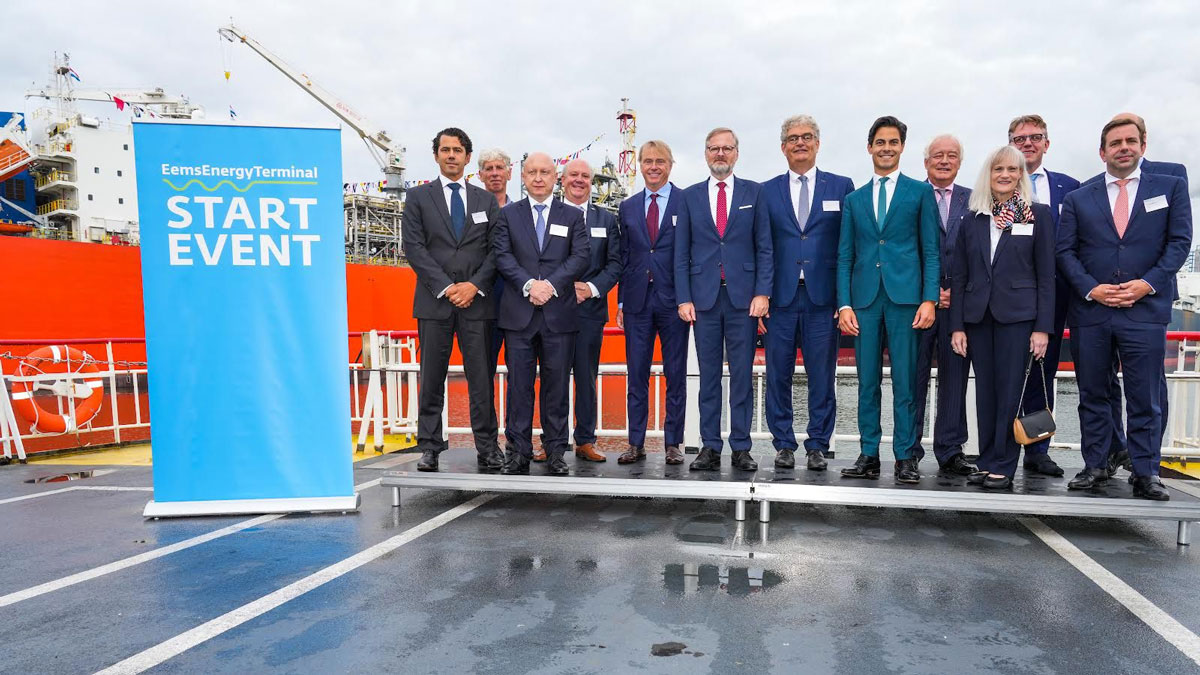First Natural Gas Available from EemsEnergyTerminal in Mid-September
On Thursday 8 September, in the presence of Minister Rob Jetten (Climate and Energy), Prime Minister Petr Fiala of the Czech Republic, the Executive Board of Gasunie and various international contacts, the official start was given to the construction phase of the EemsEnergyTerminal, a floating LNG terminal in the Eemshaven (Groningen). The first LNG tanker also arrived that day. It is expected that the first natural gas will flow into Gasunie’s gas network as early as mid-September.
Various technical activities will continue over the next few weeks. The LNG terminal is expected to be operating at full capacity by the end of November/beginning of December.
Record time
Every effort has been made to build this terminal, which will be completed in record time. Approximately 500 employees are involved. In the past few days, two FSRUs (Floating Storage Regasification Units) – the Golar Igloo and the Eemshaven LNG – have been moored in the port. Together they form the terminal where liquefied natural gas (LNG), delivered by tanker, is turned into gaseous form.
“The EemsEnergyTerminal makes an important contribution to the security of supply and helps the Netherlands and Europe to reduce their dependence on Russian gas. In the longer term Gasunie wants to use the terminal for green hydrogen. In this way, the EemsEnergyTerminal will be able to contribute to the energy supply in the Netherlands and Europe for many years to come,” Han Fennema, CEO Gasunie, commented.
“It is very good news that Gasunie, together with all the parties involved at home and abroad, has been able to realise the new LNG terminal so quickly. In addition to saving as much energy as possible and filling the gas storage facilities, the import of liquid gas is indispensable for the security of gas supply in the coming winter. The arrival of the new LNG terminal is an important step not only for the Netherlands, but for the whole of Europe towards reducing its dependence on energy from Russia as quickly as possible,” Rob Jetten, Minister for Climate and Energy, added.
“This is a significant step for strengthening energy security of the Czech Republic. Today, we have set out on the path of energy independence from Russia. The capacity leased in the terminal is able to secure as much as one-third of the Czech Republic’s annual consumption,” Petr Fiala, Prime Minister of the Czech Republic, noted.
How the EmsEnergyTerminal works
The FSRUs: the Eemshaven LNG (Exmar) and the Golar Igloo (New Fortress Energy) are leased for a period of five years and are located in one of the Eemshaven harbour basins. The incoming boats transporting LNG will in turn moor ship-to-ship to the Golar Igloo for unloading. From there it can be transhipped to the Eemshaven LNG. Both FSRUs can ‘regasify’ and feed gas into Gasunie’s gas pipeline network. A natural gas pipeline and a hot water pipeline have been laid on the quay. There are also connecting pipelines between the FSRUs for the aforementioned transport of LNG. A new gas pipeline has been laid from the quay to Gasunie’s existing network. Outside the terminal, the gas pipeline is entirely underground. And although they are physically two FSRUs, EemsEnergyTerminal will provide services to users as a single terminal. The EemsEnergyTerminal will be able to make a total of 8 billion cubic metres of natural gas per year available to the national natural gas network after processing the LNG supplied.
Until this year, the Netherlands only had an LNG terminal in the port of Rotterdam. The expansion in the Eemshaven and the optimisation of the terminal in Rotterdam will double the import capacity for LNG.
About Gasunie
Gasunie is a European energy-infrastructure company. Gasunie’s network is one of the largest high-pressure pipeline networks in Europe, comprising over 17,000 kilometres of pipeline in the Netherlands and northern Germany. Gasunie provides natural and green gas transport services through its subsidiaries, Gasunie Transport Services B.V. (GTS) in the Netherlands and Gasunie Deutschland in Germany. With its cross-border gas infrastructure and services, Gasunie facilitates TTF, which has become the leading European gas trading point. Gasunie also provides other gas infrastructure services, including gas storage and LNG. Gasunie wants to help accelerate the transition to a CO2-neutral energy supply and believes that gas-related innovations, for instance in the form of renewable gases such as hydrogen and green gas, can make an important contribution. Both existing and new gas infrastructure play a key role here. Gasunie also plays an active part in the development of other energy infrastructure to support the energy transition.







